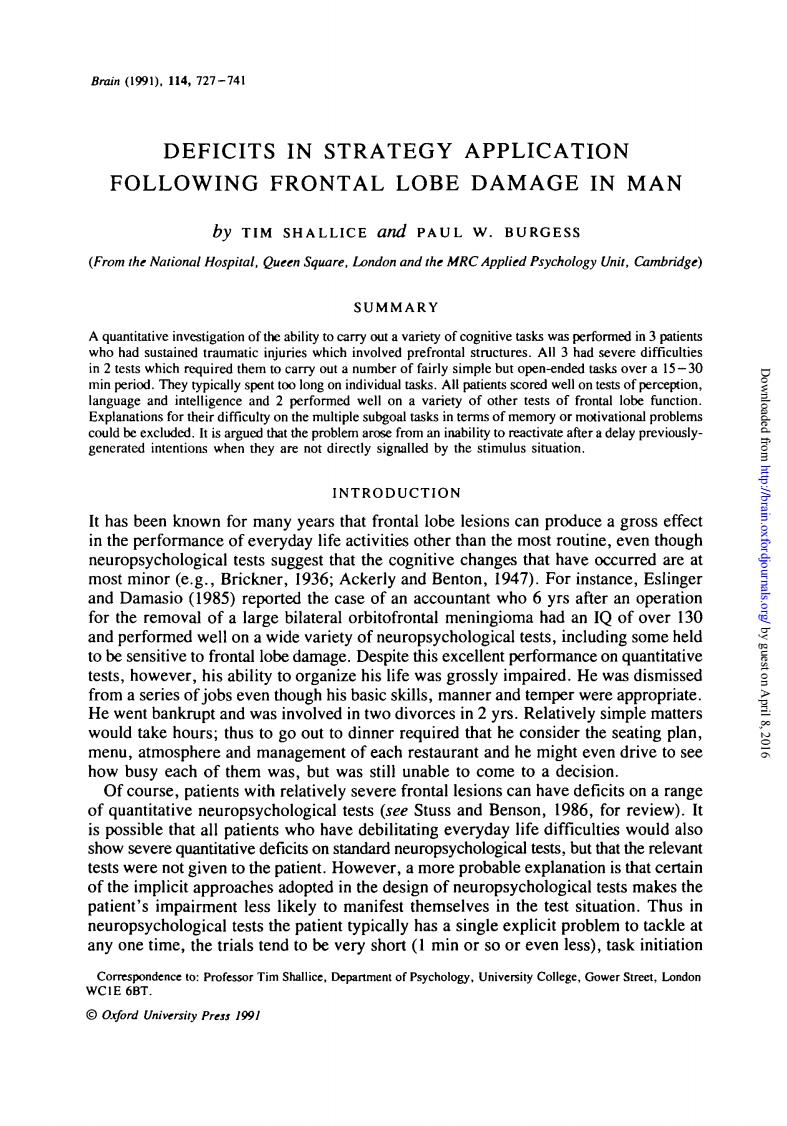正在加载图片...

Bmn(1991).114,727-741 DEFICITS IN STRATEGY APPLICATION FOLLOWING FRONTAL LOBE DAMAGE IN MAN by TIM SHALLICE and PAUL W.BURGESS (From the National Hospital.Oueen Square.London and the MRC Applied Psychology Unit.Cambridge SUMMARY A quantitative investigation of the ability to carry ou a variety of cognitive tasks was performed ded tasks min period.They iemfcnd2cromedcwcdonaaiey,of er test enerad inenonseealy prey could be excluded.It is INTRODUCTION It has been known for many years that frontal lobe lesions can produce a gross effect n the anc of ryday lif ties other than the m routin th gical tests est that the co gnitive cha s that hay ed a nor (e 1936:Ackerly d B 1047)Fo Esl and Damasic i985) tad th ountant who 6 r a for the noval of a bilateral hitof ha d an IQ of 120 nd perfo ide n ts,inclu obe dam exce by gues est his y mp He wa. ven tougn .Re p uld take hou ide go ou uire ed that on April 8.201 ma of each an d he busy eac was still ble 011 pat ents vith la can hay 90 Stuss ar 198 ng th who have c ng eve diff de but th given e pa in thev re proba e th appro tient's impa ikely to pa ent typi ly has explicit pro any one time,the trials tend to be very short (I min or so or even ess).tas ©Oxford Universiry Pres时I9l Brain (1991), 114, 727-741 DEFICITS IN STRATEGY APPLICATION FOLLOWING FRONTAL LOBE DAMAGE IN MAN by TIM SHALLICE and PAUL W. BURGESS (From the National Hospital, Queen Square, London and the MRC Applied Psychology Unit, Cambridge) SUMMARY A quantitative investigation of the ability to carry out a variety of cognitive tasks was performed in 3 patients who had sustained traumatic injuries which involved prefrontal structures. All 3 had severe difficulties in 2 tests which required them to carry out a number of fairly simple but open-ended tasks over a 15 — 30 min period. They typically spent too long on individual tasks. All patients scored well on tests of perception, language and intelligence and 2 performed well on a variety of other tests of frontal lobe function. Explanations for their difficulty on the multiple subgoal tasks in terms of memory or motivational problems could be excluded. It is argued that the problem arose from an inability to reactivate after a delay previouslygenerated intentions when they are not directly signalled by the stimulus situation. INTRODUCTION It has been known for many years that frontal lobe lesions can produce a gross effect in the performance of everyday life activities other than the most routine, even though neuropsychological tests suggest that the cognitive changes that have occurred are at most minor (e.g., Brickner, 1936; Ackerly and Benton, 1947). For instance, Eslinger and Damasio (1985) reported the case of an accountant who 6 yrs after an operation for the removal of a large bilateral orbitofrontal meningioma had an IQ of over 130 and performed well on a wide variety of neuropsychological tests, including some held to be sensitive to frontal lobe damage. Despite this excellent performance on quantitative tests, however, his ability to organize his life was grossly impaired. He was dismissed from a series of jobs even though his basic skills, manner and temper were appropriate. He went bankrupt and was involved in two divorces in 2 yrs. Relatively simple matters would take hours; thus to go out to dinner required that he consider the seating plan, menu, atmosphere and management of each restaurant and he might even drive to see how busy each of them was, but was still unable to come to a decision. Of course, patients with relatively severe frontal lesions can have deficits on a range of quantitative neuropsychological tests {see Stuss and Benson, 1986, for review). It is possible that all patients who have debilitating everyday life difficulties would also show severe quantitative deficits on standard neuropsychological tests, but that the relevant tests were not given to the patient. However, a more probable explanation is that certain of the implicit approaches adopted in the design of neuropsychological tests makes the patient's impairment less likely to manifest themselves in the test situation. Thus in neuropsychological tests the patient typically has a single explicit problem to tackle at any one time, the trials tend to be very short (1 min or so or even less), task initiation Correspondence to: Professor Tim Shallice, Department of Psychology, University College, Gower Street, London WCIE 6BT. © Oxford University Press 1991 by guest on April 8, 2016 http://brain.oxfordjournals.org/ Downloaded from